
Population 2004 n° 5
2004
- Why People Stay: The Impact of Community Context on Nonmigration in the USA - Irwin Michael, Blanchard Troy, Tolbert Charles, Nucci Alfred, Lyson Thomas
The Demographic Situation in France
- Recent Demographic Developments in France - Prioux France
- Recent Immigration Trends in France and Elements for a Comparison with the United Kingdom - Thierry Xavier
Short Papers
- Designing a Survey on Adoption in France - J. Halifax, C. Villeneuve-Gokalp
- A Person-Period Approach to Analysing Birth Histories - B. Schoumaker
- Estimation of French Internal Migration in the Period 1990-1999 and Comparison with Earlier Periods - D. Courgeau, É. Lelièvre
Irwin Michael, Blanchard Troy, Tolbert Charles, Nucci Alfred, Lyson Thomas
Most prior research on US migration has relied on individual-level explanations of moving. In this study we build on this literature by examining the role of community structure upon individuals’ probabilities of not migrating between 1985 and 1990. Using the full 1990 Census sample long-form microdata, we re-allocate adult persons in 1990 to their 1985 counties of residence. Then, using county of origin macro-structural variables (derived from the Economic Census microdata) and individual characteristics (from Decennial Census microdata), we develop a two-level hierarchical linear model. In level 1, we construct a logistic equation modelling individual probabilities of nonmigration. In level 2, we model the additive contextual effects of origin community structure on these models and then we model interactive cross-level effects. The community factors fall into two categories: 1) economic conditions that comprise the usual aggregate "push" factors, and 2) civic community factors that act to retain people in their communities. Results specify the relationship between community context and individual migration patterns and demonstrate effects of local economic structure and local civic structure on these individual behaviours. We find that, net of community economic factors and individual characteristics, civic attributes of communities are associated additively with a propensity to stay in place. Moreover, we find that certain community civic characteristics interact with personal and familial attributes to condition the effects of the individual characteristics on the likelihood of migration.
The Demographic Situation in FranceRecent Demographic Developments in FrancePrioux France
France has registered a relatively high natural increase and a rather weak estimated net migration, although the number of aliens issued with residence permits has risen sharply since 1997. While fertility has been running at nearly 1.9 children per woman for the past four years, completed cohort fertility has been dropping steeply since the 1960 cohort, and could fall below two children per woman in the 1970 cohort. Civil unions (PACSs) are rising every year, but marriages have been decreasing since 2000. The proportion of the never-married (in legal terms) thus continues to rise from one cohort to the next. The proportion of men never having lived in a stable partnership is also on a mild uptrend, as is the age of first union formation. Marriages after union formation are becoming less common, and dissolutions more common, so that an ever greater number of men and women form several successive unions. After a period of stability, the frequency of divorce has started rising again in the past two years. Life expectancy at birth for women (82.9 years in 2003) is rising more slowly than that of men (75.9 years). The resulting convergence should persist, as excess male mortality due to cancer is now decreasing. Because of an exceptional heat wave, 2003 witnessed about 15,000 more deaths than normal, mostly among older persons, particularly women over 75.
Recent Immigration Trends in France and Elements for a Comparison with the United Kingdom
Thierry Xavier
Immigration flows to France, measured essentially on the basis of the number of foreigners obtaining their first residence permit valid for one year or more, have increased since the late 1990s: the number admitted for legal residence rose from 145,000 in 1999 to 206,000 in 2002. Using the information in the records of residence permits issued by the Ministry of the Interior, the article describes the characteristics of the immigrants (sex, age, nationality, etc.). It also sheds light on the itineraries of the foreigners, reconstituting the stages prior to obtaining the first permit (notably the length of time between arriving in France and becoming legally resident) and those that followed (proportion of permits renewed). Among third-country nationals admitted for residence in the late 1990s, slightly over 10% had lived as illegal residents for at least one year before, and over 80% extended their stay after expiry of their first one-year permit. Using unpublished data supplied by the UK Office for National Statistics, the article goes on to compare recent immigration flows in France and in the United Kingdom. The latter has higher immigration, but the characteristics of the immigrants are quite similar in both countries. Thus, as in France, work is the main motive for immigration into Great Britain (31%), followed by study (28%) and then family reasons (21%).
Prix TTC : 20,00 €

